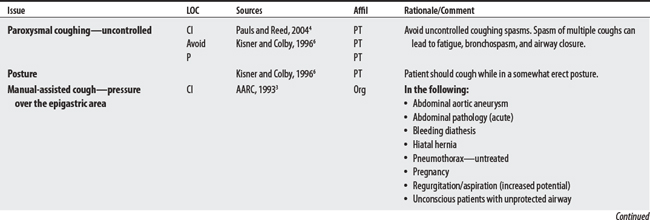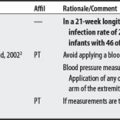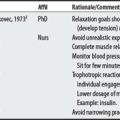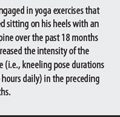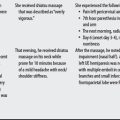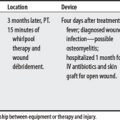Chapter 35 Breathing
INCENTIVE RESPIRATORY SPIROMETRY
OVERVIEW.
Incentive respiratory spirometry involves a technique of taking slow deep breaths for a sustained maximal inspiration (fully inflate lungs) using a medical device that provides visual feedback. It is used to prevent or treat atelectasis after surgery and to treat restrictive lung defects associated with dysfunctional diaphragm or quadriplegia.1
SUMMARY: CONTRAINDICATIONS AND PRECAUTIONS.
Four sources cited a total of nine concerns for incentive spirometry. Concerns ranged from one to four per source, with the American Association of Respiratory Care (AARC)1 and a physician citing the largest number and a physical therapist citing the fewest. The largest proportion of concerns were device-related, such as how the device is used. The most frequently cited concerns were patients who either had a limited vital capacity or were uncooperative.
F00-F99 MENTAL AND BEHAVIORAL DISORDERS
J00-J99 DISEASES OF THE RESPIRATORY SYSTEM
1 AARC. Clinical practice guideline, incentive spirometry. Respir Care. 1991;36:1404-1405.
2 Peruzzi WT, Smith B. Bronchial hygiene therapy. Crit Care Clin. 1995;11(1):79-96.
3 Pullen RLJr. Clinical do’s and don’ts: Teaching bedside incentive spirometry. Nursing. 2003;33(8):24.
4 Kisner C, Colby LA. Therapeutic exercise: foundations and techniques, ed 3. Philadelphia: F.A. Davis, 1996.
5 McConnell EA. Teaching pursed-lip breathing. Nursing. 1999;29(9):18.
35.2 Coughing (Cough Therapy)
OVERVIEW.
A cough (reflex) is the expulsion of air from the lungs, performed in a noisy, sudden manner.1 The sequence involves a brief inspiration, glottis closure, an expiratory muscle contraction (i.e., abdominals), increased pressures within the thorax and abdomen, the opening of the epiglottis, and the expulsion of air and sometimes foreign matter and sputum. It is used to clear secretions from the main bronchi and trachea.2
CONTRAINDICATIONS AND PRECAUTIONS
COUGHING
A00-B99 CERTAIN INFECTIONS AND PARASITIC DISEASES
G00-G99 DISEASES OF THE NERVOUS SYSTEM
I00-I99 DISEASES OF THE CIRCULATORY SYSTEM
J00-J99 DISEASES OF THE RESPIRATORY SYSTEM
M00-M99 DISEASES OF THE MUSCULOSKELETAL SYSTEM
S00-T98 INJURY, POISONING, AND CERTAIN OTHER CONSEQUENCES OF EXTERNAL CAUSES
1 Dorland’s illustrated medical dictionary. ed 24. Philadelphia: W.B. Saunders; 1965.
2 Thomson A, Skinner A, Piercy J. Tidy’s physiotherapy, ed 12. Oxford: Butterworth-Heinemann, 1991.
3 AARC. Clinical practice guideline, direct cough. Respir Care. 1993;38:495-499.
4 Pauls JA, Reed KL. Quick reference to physical therapy, ed 2. Austin (TX): Pro-Ed, 2004.
5 Obuchowska I, Mariak Z, Stankiewicz A. Massive suprachoroidal hemorrhage during cataract surgery, case report (in Polish—from abstract). Klin Oczna. 2002;104(5-6):406-410.
6 Kisner C, Colby LA. Therapeutic exercise: foundations and techniques, ed 3. Philadelphia: F.A. Davis, 1996.
7 Musnick D, Hall C. Red flags: potentially serious symptoms and signs in exercising patients. In: Hall CM, Brody LT, editors. Therapeutic exercise: moving toward function. Philadelphia: Lippincott Williams & Wilkins, 2005.
8 Imle PC. Physical therapy and respiratory care for the patient with acute spinal cord injury. Phys Ther Health Care. 1987;1:45.

















